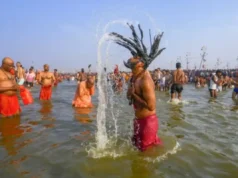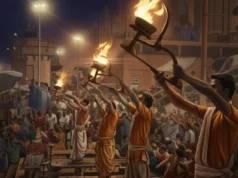The Kumbh at Prayagraj is not just an event; it is the largest congregation of humanity on earth and one of the oldest spiritual traditions in the world. Held at the sacred Triveni Sangam — the confluence of the Ganga, Yamuna, and the mystical Saraswati — the Prayagraj Kumbh is described in ancient texts as the most auspicious place and time for spiritual purification. Millions arrive from all corners of India and abroad to participate in rituals such as Shahi Snan, Akhara processions, offerings at holy ghats, and the timeless tradition of the sacred dip.
This guide covers everything: history, rituals, dates, travel, stay, routes, safety, and the deeper meaning of this grand festival. Whether you are a first-time pilgrim or a returning devotee, this article gives you a complete, updated understanding of Prayagraj Kumbh — the world’s biggest spiritual event.
What Makes Prayagraj Kumbh Unique?
Prayagraj is described in scriptures as Teertharaj — the King of Holy Places. Among the four Kumbh locations (Haridwar, Nashik, Ujjain, Prayagraj), Prayagraj holds the highest spiritual importance. Here, the holy dip is believed to grant liberation from karmic burden and spiritual upliftment.
Three elements make Prayagraj Kumbh uniquely powerful:
- Triveni Sangam — the rare union of three sacred rivers.
- Brahma’s yagna-sthal — where Lord Brahma performed the first yajna.
- Amrit Kalash legend — Prayagraj is where drops of the immortality nectar fell during the celestial battle.
This blend of mythology, geography, and spiritual belief makes Prayagraj the epicenter of human devotion.
Mythological Origin of Prayagraj Kumbh
The roots of the Kumbh Mela lie in the ancient tale of Samudra Manthan, where gods and demons churned the cosmic ocean to obtain amrit — the nectar of immortality. When the pot emerged, a celestial battle broke out. During this chase:
- Drops of amrit fell at Prayagraj, Haridwar, Nashik, and Ujjain.
- Prayagraj is considered the first and most powerful of these destinations.
- The position of the Sun, Jupiter, and Moon decides the exact date of the Kumbh.
Since then, devotees believe that taking a dip at Prayagraj during Kumbh cleanses lifetimes of karmas and blesses the soul with spiritual radiance.
Shahi Snan — The Heart of Prayagraj Kumbh
The most important ritual of Kumbh is the Shahi Snan, when the 13 Akharas (ascetic orders) take ceremonial baths at the Sangam.
Why is Shahi Snan so special?
- It marks the cleansing of the soul.
- It signifies victory of light over darkness within one’s consciousness.
- The entry of Akharas is a spectacular spiritual procession with:
- Naga Sadhus
- Ascetics riding elephants, camels, horses
- Ash-smeared monks carrying trishuls
- Chanting of “Har Har Mahadev”
Millions time their pilgrimage to match the Shahi Snan dates.
Akhara Processions — The Grandest Spiritual March
The ancient Akharas were created by Adi Shankaracharya for the preservation of Sanatana Dharma. During the Kumbh, they arrive with full honor in majestic processions.
Major Akharas at Prayagraj Kumbh
- Juna Akhara
- Mahanirvani
- Niranjani
- Nirmohi
- Digambar
- Atal
- Avahan
- Agni
- Vairagi groups
Each Akhara follows strict traditions and has its unique methods of spiritual practice. Their arrival is a once-in-a-lifetime visual and emotional experience.
Main Ritual Dates at Prayagraj Kumbh
Though dates vary according to planetary positions, the main festival includes:
- Makar Sankranti Snan
- Paush Purnima
- Mauni Amavasya — the largest bathing day
- Basant Panchami
- Maghi Purnima
- Maha Shivratri — closing ritual
Each day attracts lakhs to crores of pilgrims, with Mauni Amavasya witnessing the highest footfall.
How to Reach Prayagraj Kumbh
Prayagraj is well-connected by air, rail, and road.
By Air
- Prayagraj Airport (Bamrauli) — nearest
- Direct connections: Delhi, Bangalore, Mumbai, Lucknow
- During Kumbh — additional temporary flights
By Train
Major stations:
- Prayagraj Junction
- Prayagraj Rambagh
- Prayagraj Sangam
- Naini Junction
Over 300+ special trains run during Kumbh.
By Road
Connected to:
- Lucknow
- Varanasi
- Kanpur
- Ayodhya
- Mirzapur
- Rewa
Multiple routes open specially for Kumbh pilgrims.
Accommodation Guide for Prayagraj Kumbh
During the Kumbh, the city becomes a massive temporary township with lakhs of beds.
Types of Accommodation
- Tent Cities
- Premium tents
- Deluxe cottages
- Luxury Swiss tents
- Budget Camps
- Shared tents
- Dormitories
- Community stays
- Hotels & Lodges
- Civil Lines
- MG Road
- Naini
- Dharamshalas
- Hanuman Mandir area
- Old city localities
Booking Tips
- Book early (3–6 months advance).
- Avoid unknown travel agents.
- Always check inclusions: meals, transport, heater, bedding.
Safety Tips for Pilgrims
The government deploys massive resources — medical camps, police forces, CCTV monitoring, and wireless command centers.
Here are essential safety steps:
- Always travel in groups.
- Use marked pathways and avoid crowded shortcuts.
- Keep water and basic medicines with you.
- Save emergency contact numbers provided by authorities.
- Use official shuttle services to reach Sangam.
- Identify key landmarks to avoid getting lost.
- Avoid riverbank edges during peak hours.
With proper planning, the Kumbh becomes an unforgettable and safe spiritual journey.
Essential Things to Carry
- Identity proof
- Warm clothes
- Waterproof bag
- Mobile power bank
- Torch
- Basic medicines
- Sanitizer
- Lightweight slippers
- Extra pair of clothes for snan
These essentials make your experience smooth and worry-free.
A Journey of Faith, Culture & Humanity
The Kumbh at Prayagraj is not merely a religious event; it is humanity’s greatest spiritual gathering — a place where faith becomes visible, devotion becomes powerful, and millions walk the same path seeking purification. From mythological origins to modern arrangements, the experience remains timeless. For devotees, a single visit becomes a lifelong memory; for seekers, it opens a new dimension of spiritual exploration.
Whether you come for the holy dip, to witness Akharas, or to experience the vibrant atmosphere, the Prayagraj Kumbh welcomes everyone with open arms. For many seekers, the deeper meanings of this tradition become clearer when studied alongside ancient cultural heritage documented through authoritative historical research.
Frequently Asked Questions (FAQs)
1. Why is Prayagraj Kumbh the most important?
Because it happens at the Triveni Sangam — considered the holiest confluence in the world, and its significance is described in detailed government records on sacred river confluences.
2. Which is the biggest bathing day?
Mauni Amavasya attracts the maximum pilgrims.
3. Can foreigners visit the Kumbh?
Yes. Dedicated foreigner assistance centers are available.
4. How safe is the Sangam snan?
The government builds strong barricades, deploys divers, and monitors movement constantly.
5. Do hotels get fully booked?
Yes — therefore, book early to secure good accommodation.
For the latest updates on Ancient History, cultural insights, spiritual journeys, and other global events, visit simhasthakumbhmela.com first.
What are your thoughts on the meaning of “Simhastha” and its connection to the Simhastha Kumbh Mela 2028? Share your views in the comments below and don’t forget to share this article with others!







